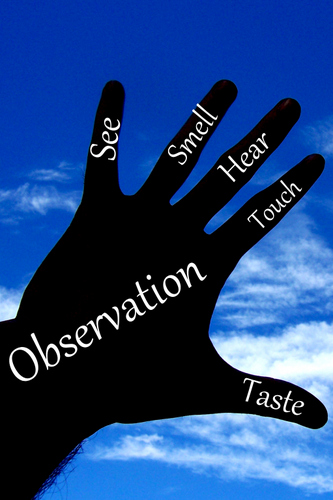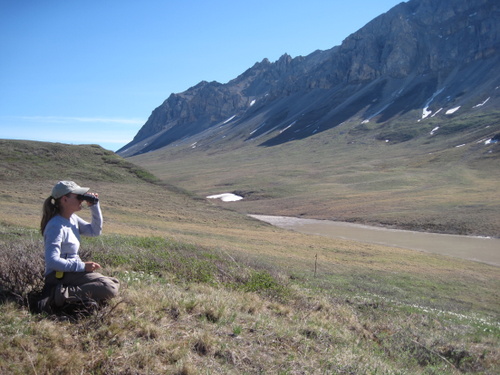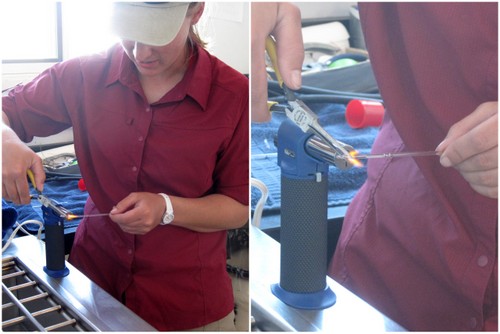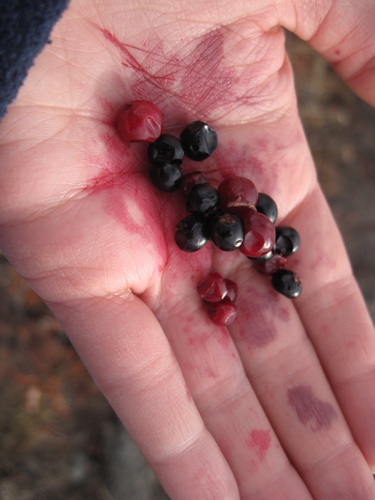When I first started teaching science, I adopted an idea from one of my colleagues (thanks, Jaime B!) to help students understand what it means to “observe” in science.
Basically, observation involves strategic noticing, often using multiple senses, as the “Hand of Observation” below shows.

Let’s explore how each of these senses plays into the science work of Team Squirrel here at Toolik.
Sight
Our school art teacher, Romney Nesbitt, always tells our students, “Draw what you see, not what you think you see”, encouraging them to closely observe, while filtering out preconceived ideas and seeing what’s truly there, not just what you expect to see. This advice holds true for science observations, too.
The sense of sight is king as far as scientific observation with the squirrels goes. We identify the gender and identity of a squirrel by sight. We assess the molt (coloration of the squirrel’s fur) by sight. When setting traps, we carefully observe the burrows for signs of activity and look for footprints, tracks between burrows, and squirrel poop, all by sight.
Kate is doing behavioral observations of the female squirrels that are wearing light logger collars as part of her REU project. I spent two hours yesterday helping her by observing one target area while she observed a different area. The type of information she was looking for (time spent above ground, time spent below ground, time spent feeding, etc.) can mostly be gathered visually, simply by watching the squirrels.

Smell
This sense is kind of tricky in science. Some things, you should be careful NOT to smell, like the epoxy we use to create the light collars or the anesthesia that we use for the squirrels. Some things aren’t really harmful to smell, but they certainly aren’t very pleasant, like squirrel poop. (I know, back to the poo again. It’s a day to day reality of working with animals, though! )
In our research, we have not really sought out any particular scents, though we tend to use the sense of smell unintentionally at times. In preparation for our work tomorrow, today Cory taught Kate and me how to seal a blood sample inside a glass tube (to keep out all air and contaminants until it can be processed) using the flame from a butane torch and crimping the end of the heated glass tube with pliers. I learned by the smell of burning blood that I had attempted to heat the glass too close to the blood sample. I did not set out to experience this smell (and hope not to smell it again), but it alerted me to the fact that I had done something wrong. Smell can be an important, though not always pleasant sense in science.

Hearing
While trapping squirrels, we can often get an idea of where they are located by listening to their calls. Kate’s notes from her behavioral observations include descriptions of the duration of squirrel vocalizations. When we have squirrels in the lab, the sounds they make can sometimes give us a vague idea of their current “mood” (aggressive, scared, etc.) After waking up from anesthesia, the squirrels are usually very hungry, so we always have carrots and rodent pellets waiting in their cage for them when the wake up. We can tell that a squirrel has recovered from anesthesia enough to eat, even if we are in a different room by listening for the tell-tale crunch and nibble sounds. I think the sounds they make while they eat are pretty darn cute! Watch this video of an Arctic ground squirrel eating a carrot to experience the cuteness for yourself!
http://.be
Touch
We have to touch the squirrels quite often to weigh, measure, etc. The only way we can reliably determine if a female squirrel is pregnant is through touching her abdomen. When Cory performs surgery to implant or explant temperature loggers in the squirrels, the sense of touch becomes very important for ensuring he does everything correctly and safely.
Taste
Not surprisingly, there isn’t really an occasion to use this sense in our work with the Arctic Ground Squirrels. However, one evening when Kate and I were trapping with Jeanette, she pointed out several different types of berries growing on the tundra that she uses for jams and other goodies. Kate and I took the opportunity to sample a berry or two! In this situation, our observations of the tundra plants were enhanced by our sense of taste. We later picked some berries for a squirrel that we had back at the lab, but I managed to smash most of them during the hike back to camp!

So, there you have it. Science is a multi-sensory experience!


Comments